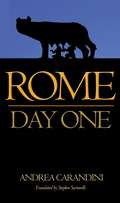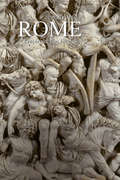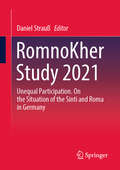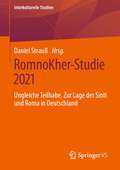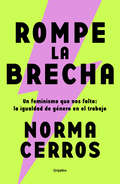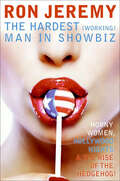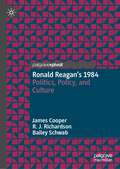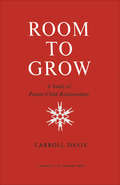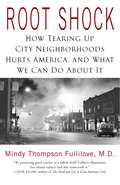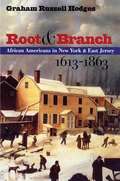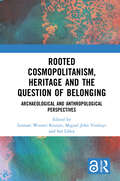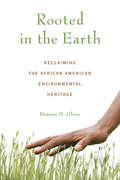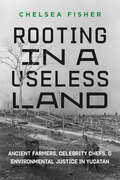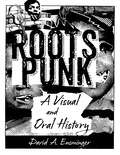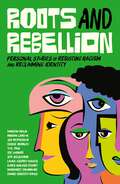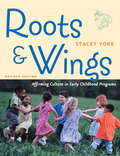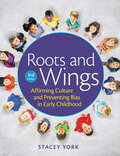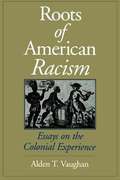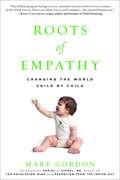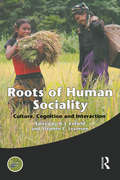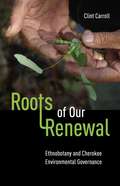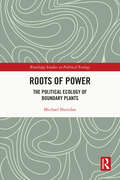- Table View
- List View
Rome: Day One
by Andrea CarandiniAndrea Carandini's archaeological discoveries and controversial theories about ancient Rome have made international headlines over the past few decades. In this book, he presents his most important findings and ideas, including the argument that there really was a Romulus--a first king of Rome--who founded the city in the mid-eighth century BC, making it the world's first city-state, as well as its most influential. Rome: Day One makes a powerful and provocative case that Rome was established in a one-day ceremony, and that Rome's first day was also Western civilization's. Historians tell us that there is no more reason to believe that Rome was actually established by Romulus than there is to believe that he was suckled by a she-wolf. But Carandini, drawing on his own excavations as well as historical and literary sources, argues that the core of Rome's founding myth is not purely mythical. In this illustrated account, he makes the case that a king whose name might have been Romulus founded Rome one April 21st in the mid-eighth century BC, most likely in a ceremony in which a white bull and cow pulled a plow to trace the position of a wall marking the blessed soil of the new city. This ceremony establishing the Palatine Wall, which Carandini discovered, inaugurated the political life of a city that, through its later empire, would influence much of the world. Uncovering the birth of a city that gave birth to a world, Rome: Day One reveals as never before a truly epochal event.
Rome: Empire of the Eagles, 753 BC – AD 476
by Neil FaulknerThe Roman Empire is widely admired as a model of civilisation. In this compelling new study Neil Faulkner argues that in fact, it was nothing more than a ruthless system of robbery and violence. War was used to enrich the state, the imperial ruling classes and favoured client groups. In the process millions of people were killed or enslaved. Within the empire the landowning elite creamed off the wealth of the countryside to pay taxes to the state and fund the towns and villas where they lived. The masses of people - slaves, serfs and poor peasants - were victims of a grand exploitation that made the empire possible. This system, riddled with tension and latent conflict, contained the seeds of its own eventual collapse.
RomnoKher Study 2021: Unequal Participation. On the Situation of the Sinti and Roma in Germany
by Daniel StraußBased on a cooperation between science and minority self-organizations, the book offers for the first time comprehensive data on the national minority of German Sinti and Roma and immigrant Roma in Germany. The social and educational situation of Sinti and Roma in Germany is examined using an innovative sampling strategy with interviewers from the minority. An international team of renowned authors from minority and majority analyzes the connections between discrimination, expectations and developments in school and training qualifications.
RomnoKher-Studie 2021: Ungleiche Teilhabe. Zur Lage der Sinti und Roma in Deutschland (Interkulturelle Studien)
by Daniel StraußDas Buch bietet auf der Basis einer Kooperation von Wissenschaft und Selbstorganisationen der Minderheit erstmals umfassend Daten über die nationale Minderheit der deutschen Sinti und Roma und zugewanderte Roma in Deutschland. Mit einer innovativen Sampling-Strategie mit Interviewer*innen aus der Minderheit wird die soziale und Bildungssituation von Sinti und Roma in Deutschland untersucht. Ein internationales Team renommierter Autor*innen aus Minderheit und Mehrheit analysiert die Zusammenhänge von Diskriminierung, Erwartungen und Entwicklungen bei Schul- und Ausbildungsabschlüssen.
Rompe la brecha: Un feminismo que nos falta: la igualdad de género en el trabajo
by Norma Cerros¿Te has preguntado alguna vez por qué hay tan pocas mujeres en puestos de liderazgo? ¿Sabes que en México -y en el mundo- hay una desigualdad sistemática en los sueldos de las mujeres y los hombres? ¿Consideras que las mujeres sacrifican su carrera profesional para hacerse cargo de las responsabilidades familiares? Si estas preguntas resuenan en tu mente, este libro es para ti. Norma Cerros, experta en derecho internacional y emprendedora, trata todos estos asuntos con profundidad para llegar a una conclusión tajante: existe una brecha de género no solo en la vida privada, sino también en el ámbito del trabajo. Ella analiza las causas y describe con detalle las distintas situaciones por las que pasan las mujeres en las empresas, pero no se queda ahí: también estudia algunos de los mitos en que se basa esta desigualdad, los cuales hemos heredado históricamente, y propone una serie de soluciones para que comencemos a romper la brecha y que a las mujeres nos depare un futuro más justo e igualitario.
Ron Jeremy: The Hardest (Working) Man in Showbiz
by Ron JeremyHe's the porn world's Everyman. Blessed with an enormous "talent" yet average looks, he's starred in more than 1,700 adult films, directed 250 of them, and over the last twenty years has become porn's biggest ambassador to the mainstream. He's appeared in 60 regular films, 14 music videos, and VH1's Surreal Life, starred in the critically acclaimed Porn star (a movie about his life), and in Being Ron Jeremy (a take off on Being John Malkovich), co-starring Andy Dick. And that's just the tip of the iceberg. . . . Ron Jeremy is a born storyteller (funny, considering he doesn't do a lot of talking in his films). He knows where all the bodies are buried, and in this outrageous autobiography he not only shows you the grave but also gives you the back story on the tombstone. Get ready for Ron Jeremy—a scandalously entertaining deep insider's view of the porn industry and its emergence into popular culture, and a delectable self-portrait of the amazingly endowed Everyman every man wanted to be.
Ronald Reagan’s 1984: Politics, Policy, and Culture
by James Cooper R.J. Richardson Bailey SchwabForty years after Ronald Reagan’s successful re-election campaign, this book explores the significance of the year 1984 in the making of Reagan’s presidential record and the shaping of his legacy. The authors examine the broader context of how Reagan impacted the nature of the US presidency and international relations during the Cold War, and how this in turn interacted with American popular culture. Serving as an introduction to academics, students and the interested public into what is a rapidly increasingly Reagan scholarship, this book will also appeal to anyone interested in US elections, the evolving nature of the US presidency, and American culture more generally.
Ronald W. Walters and the Fight for Black Power, 1969-2010 (SUNY series in African American Studies)
by Robert C. SmithFrom his leadership of the first modern lunch counter sit-ins at age twenty to his work on African American reparations at the time of his death at age seventy-two, Ronald W. Walters (1938–2010) was at the cutting edge of African American politics. A preeminent scholar, activist, and media commentator, he was founding chair of the Black Studies Department at Brandeis, where he shaped the epistemological parameters of the new discipline. Walters was an early strategist of congressional black power and a longtime advocate of a black presidential candidacy. His writings on the politics of race in America both predicted the constraints on President Obama in advancing African American interests and anticipated the emergence of the white nationalism found in the Tea Party and Donald Trump insurgency. In this fascinating book, Robert C. Smith combines history and biography to offer an overview of the last half century of black politics in America through the lens of the life and work of the man often described as the W. E. B. Du Bois of his time.
Room to Grow: A Study of Parent-Child Relationships
by Carroll DavisThe lives of seven children provides the focus for this penetrating look into the experiences that shape personality. As they emerge from the records collected over a twenty-year period by the University of Toronto's Institute of Child Study, they reveal the problems and frustrations met with in the process of growing up and point to the strong influences which family relationships have on mental and emotional development. The records themselves, drawn from interviews and questionnaires administered to mothers and children are unusual in their extensiveness. Covering the important years from nursery school through adolescence, they give unusual opportunity for a significant long-term study of the personality changes in individual children. Room to Grow is a source of insight into the needs of children and the problems of parents. As such it is an important book for parents seeking to establish a just balance between domination and permissiveness in their relations with their children. In addition, in its handling of the heterogeneous data resulting from longitudinal psychological research, the book will serve as a model of method and achievement for those who wish to build on the foundation its author has laid.
Root Shock
by Mindy FulliloveThey called it progress. But for the people whose homes and districts were bulldozed, the urban renewal projects that swept America starting in 1949 were nothing short of assault. Vibrant city blocks--places rich in history--were reduced to garbage-strewn vacant lots. When a neighborhood is destroyed its inhabitants suffer "root shock": a traumatic stress reaction related to the destruction of one's emotional ecosystem. The ripple effects of root shock have an impact on entire communities that can last for decades. In this groundbreaking and ultimately hopeful book, Dr. Mindy Fullilove examines root shock through the story of urban renewal and its effect on the African American community. Between 1949 and 1973 this federal program, spearheaded by business and real estate interests, destroyed 1,600 African American neighborhoods in cities across the United States. But urban renewal didn't just disrupt the black community. The anger it caused led to riots that sent whites fleeing for the suburbs, stripping them of their own sense of place. And it left big gashes in the centers of U.S. cities that are only now slowly being repaired. Focusing on three very different urban settings--the Hill District of Pittsburgh, the Central Ward in Newark, and the small Virginia city of Roanoke--Dr. Fullilove argues powerfully that the twenty-first century will be one of displacement and of continual demolition and reconstruction. Acknowledging the damage caused by root shock is crucial to coping with its human toll and building a road to recovery.Astonishing in its revelations, unsparing in its conclusions, Root Shock should be read by anyone who cares about the quality of life in American cities--and the dignity of those who reside there.From the Hardcover edition.
Root and Branch
by Graham Russell HodgesIn this remarkable book, Graham Hodges presents a comprehensive history of African Americans in New York City and its rural environs from the arrival of the first African--a sailor marooned on Manhattan Island in 1613--to the bloody Draft Riots of 1863. Throughout, he explores the intertwined themes of freedom and servitude, city and countryside, and work, religion, and resistance that shaped black life in the region through two and a half centuries. Hodges chronicles the lives of the first free black settlers in the Dutch-ruled city, the gradual slide into enslavement after the British takeover, the fierce era of slavery, and the painfully slow process of emancipation. He pays particular attention to the black religious experience in all its complexity and to the vibrant slave culture that was shaped on the streets and in the taverns. Together, Hodges shows, these two potent forces helped fuel the long and arduous pilgrimage to liberty.
Root and Branch: African Americans in New York and East Jersey, 1613-1863
by Graham Russell HodgesDrawing upon court records, letters, census data, and a host of other sources, the author traces the history of African Americans in New York and East Jersey from the colonial era until emancipation in 1863. He demonstrates that African Americans developed a vibrant culture, and that the movement toward freedom was ceaseless despite oppression.
Rooted Cosmopolitanism, Heritage and the Question of Belonging: Archaeological and Anthropological perspectives
by Miguel John Versluys Ian Lilley Lennart Wouter KruijerThis book explores the analytical and practical value of the notion of "rooted cosmopolitanism" for the field of cultural heritage.Many concepts of present-day heritage discourses - such as World Heritage, local heritage practices, or indigenous heritage - tend to elide the complex interplay between the local and the global - entanglements that are investigated as "glocalisation" in Globalisation Studies. However, no human group ever creates more than a part of its heritage by itself. This book explores an exciting new alternative in scholarly (critical) heritage discourse, the notion of rooted cosmopolitanism, a way of making manifestations of globalised phenomena comprehensible and relevant at local levels. It develops a critical perspective on heritage and heritage practices, bringing together a highly varied yet conceptually focused set of stimulating contributions by senior and emerging scholars working on the heritage of localities across the globe. A contextualising introduction is followed by three strongly theoretical and methodological chapters which complement the second part of the book, six concrete, empirical chapters written in "response" to the more theoretical chapters. Two final reflective conclusions bring together these different levels of analysis.This book will appeal primarily to archaeologists, anthropologists, heritage professionals, and museum curators who are ready to be confronted with innovative and exciting new approaches to the complexities of cultural heritage in a globalising world.The Open Access version of this book, available at http://www.taylorfrancis.com, has been made available under a Creative Commons Attribution-Non Commercial-No Derivatives (CC-BY-NC-ND)] 4.0 license.
Rooted in the Earth: Reclaiming the African American Environmental Heritage
by Dianne GlaveWith a basis in environmental history, this groundbreaking study challenges the idea that a meaningful attachment to nature and the outdoors is contrary to the black experience. The discussion shows that contemporary African American culture is usually seen as an urban culture, one that arose out of the Great Migration and has contributed to international trends in fashion, music, and the arts ever since. But because of this urban focus, many African Americans are not at peace with their rich but tangled agrarian legacy. On one hand, the book shows, nature and violence are connected in black memory, especially in disturbing images such as slave ships on the ocean, exhaustion in the fields, dogs in the woods, and dead bodies hanging from trees. In contrast, though, there is also a competing tradition of African American stewardship of the land that should be better known. Emphasizing the tradition of black environmentalism and using storytelling techniques to dramatize the work of black naturalists, this account corrects the record and urges interested urban dwellers to get back to the land.
Rooting in a Useless Land: Ancient Farmers, Celebrity Chefs, and Environmental Justice in Yucatan
by Chelsea FisherIn Rooting in a Useless Land, Chelsea Fisher examines the deep histories of environmental-justice conflicts in Mexico's Yucatán Peninsula. She draws on her innovative archaeological research in Yaxunah, an Indigenous Maya farming community dealing with land dispossession, but with a surprising twist: Yaxunah happens to be entangled with prestigious sustainable-development projects initiated by some of the most famous chefs in the world. Fisher contends that these sustainable-development initiatives inadvertently bolster the useless-land narrative—a colonial belief that Maya forests are empty wastelands—which has been driving Indigenous land dispossession and environmental injustice for centuries. Rooting in a Useless Land explores how archaeology, practiced within communities, can restore history and strengthen relationships built on contested ground.
Roots Punk: A Visual and Oral History (American Made Music Series)
by David A. EnsmingerPunk rock evokes dissent and disruption, abrasive and anarchic musicality, and a host of countercultural aesthetics. Featuring original interviews and over one hundred images, Roots Punk: A Visual and Oral History by longtime music journalist and author David A. Ensminger focuses on how punk merged with roots music to create a rich style that incorporated honky-tonk, rockabilly, doo-wop, reggae, ska, jazz, folk, blues, and labor ballads. This engagement transformed the notion of punk to include a wide array of vintage source material that seems more aligned with bolo ties and Stetsons than Doc Martens and safety pins. Ensminger explores the music’s aesthetics, traits, and themes. He contextualizes, clarifies, maps, and probes roots punk’s hybrid nature as well as its diverse, queer-inclusive, and multicultural strains. By painting a broad, nuanced, and well-documented picture of the genre from its earliest incarnation, he forms a kind of people’s history of the movement. Roots Punk features original interviews with members of Minutemen, MDC, the Dicks, the Plimsouls, Tex and the Horseheads, Dils/Rank and File, X, the Flesh Eaters, Beatnigs, Alejandro Escovedo, Robert “El Vez” Lopez, Blasters, and more. Whether covering sarcastic novelty forms or sincere embraces, Ensminger reveals and revels in a punk tradition lined with blues records, acoustic ballads, country, and hillbilly romp. In a time of growing conformity, replication, and commercialization, roots punk (sometimes dubbed cow-punk) offers a tantalizing revitalization and reimagination of the American songbook.
Roots and Rebellion: Personal Stories of Resisting Racism and Reclaiming Identity
by Various AuthorsDespite the UK's long history of racial injustice, people from minoritised groups have fought back, engaging in advocacy, activism, and every-day acts of resistance to create positive change.This anthology is a prize-winning collection of these stories, spanning generations, cultures, and communities. They tell of subtle everyday acts of resistance like cooking traditional dishes from recipes passed down from grandparents displaced from their homelands, challenging microaggressions in the workplace, and sending care packages to relatives in occupied states. They also highlight bold and defiant rebellions such as building a successful business from scratch and against the odds, making perilous journeys, and fighting unlawful deportation.The fabric of these stories is made up of resistance, but also of belonging. They explore the complexities of feeling caught between identities as well as the joyful freedom found in reclaiming and rediscovering who you are.Full of humanity and bravery, this inspiring and unique kaleidoscope of journeys speaks to how nuanced and personal resistance against racism can be.
Roots and Wings, Revised Edition
by Stacey York"Roots and Wings will open doors to beginners in cultural diversity education, and will enrich the more experienced readers. It is a grand tool for assisting early childhood educators to address the many-faceted and complex issues of cultural diversity and racial prejudice. . . . I recommend this book to any teacher, caregiver, or parent who wants to begin learning what it means to foster young children's respect for themselves and others."--Louise Derman-Sparks, author, AntiBias CurriculumMore than a decade ago, Roots and Wings was published as the first practical resource for early childhood teachers on the then new topic of multicultural education. This invaluable guide is now completely updated to respond to present day anti-bias issues in educating young children.Roots and Wings provides a thorough, clear, and practical introduction to working with diverse children and families in early childhood settings. With more than 100 new and revised activities, practical examples, and staff training recommendations, the revised edition includes new chapters on bilingual education, culturally responsive teaching, and children and prejudice. Seamlessly blending theory and practice, Roots and Wings is an ideal resource for preschool teachers, early childhood programs at colleges and universities, and training workshops.Stacey York is an instructor in the Child Development Department at Minneapolis Community and Technical College, Minneapolis, Minnesota. She conducts multicultural workshops around the country and is also the author of Big As Life: The Everyday Inclusive Curriculum.
Roots and Wings: Affirming Culture and Preventing Bias in Early Childhood
by Stacey YorkUse the updated activities, examples, and research to improve your anti-bias and multicultural education programs. This clear and practical guide includes expanded information on English language learners, family engagement, culturally responsive teaching, and staff training. Stacey York teaches child development at Rochester Community and Technical College and established E-LECT, a collaborative effort between thirteen Minnesota community and technical colleges to provide e-learning for early childhood teachers.
Roots of American Racism: Essays on the Colonial Experience
by Alden T. VaughanThis collection brings together ten of Alden Vaughan's essays about race relations in the British colonies. Focusing on the variable role of cultural and racial perceptions on colonial policies for Indians and African Americans, the essays include explorations of the origins of slavery and racism in Virginia, the causes of the Puritans' war against the Pequots, and the contest between natives and colonists to win the other's allegiance by persuasion or captivity.
Roots of Empathy: Changing the World, Child by Child
by Mary Gordon Daniel J. SiegelRoots of empathy--an evidence-based program developed in 1996 by longtime educator and social entrepreneur Mary Gordon--has already reached more than 270,000 children in Canada, the U.S., Japan, Australia, New Zealand, and elsewhere. Now, as The New York Times reports that empathy lessons are spreading everywhere amid concerns over the pressure on students from high-stakes tests and a race to college that starts in kindergarten, Mary Gordon explains the value of and how best to nurture empathy and social and emotional literacy in all children-and thereby reduce aggression, antisocial behavior, and bullying.
Roots of Entanglement: Essays in the History of Native-Newcomer Relations
by Myra Rutherdale P. Lackenbauer Kerry AbelRoots of Entanglement offers an historical exploration of the relationships between Indigenous peoples and European newcomers in the territory that would become Canada. Various engagements between Indigenous peoples and the state are emphasized and questions are raised about the ways in which the past has been perceived and how those perceptions have shaped identity and, in turn, interaction both past and present. Specific topics such as land, resources, treaties, laws, policies, and cultural politics are explored through a range of perspectives that reflect state-of-the-art research in the field of Indigenous history. Editors Myra Rutherdale, Whitney Lackenbauer, and Kerry Abel have assembled an array of top scholars including luminaries such as Keith Carlson, Bill Waiser, Skip Ray, and Ken Coates. Roots of Entanglement is a direct response to the Truth and Reconciliation Commission’s call for a better appreciation of the complexities of history in the relationship between Indigenous and non-Indigenous peoples in Canada.
Roots of Human Sociality: Culture, Cognition and Interaction
by N. J. EnfieldThis book marks an exciting convergence towards the idea that human culture and cognition are rooted in the character of human social interaction, which is unique in the animal kingdom. Roots of Human Sociality attempts for the first time to explore the underlying properties of social interaction viewed from across many disciplines, and examines their origins in infant development and in human evolution. Are interaction patterns in adulthood affected by cultural differences in childhood upbringing? Apes, unlike human infants of only 12 months, fail to understand pointing and the intention behind it. Nevertheless apes can imitate and analyze complex behavior - how do they do it? Deaf children brought up by speaking parents invent their own languages. How might adults deprived of a fully organized language communicate?This book makes the case that the study of these sorts of phenomenon holds the key to understanding the foundations of human social life. The conclusion: our unique brand of social interaction is at the root of what makes us human.
Roots of Our Renewal: Ethnobotany and Cherokee Environmental Governance (First Peoples: New Directions in Indigenous Studies)
by Clint CarrollHonorable Mention: Labriola Center American Indian National Book Award In Roots of Our Renewal, Clint Carroll tells how Cherokee people have developed material, spiritual, and political ties with the lands they have inhabited since removal from their homelands in the southeastern United States. Although the forced relocation of the late 1830s had devastating consequences for Cherokee society, Carroll shows that the reconstituted Cherokee Nation west of the Mississippi eventually cultivated a special connection to the new land—a connection that is reflected in its management of natural resources.Until now, scant attention has been paid to the interplay between tribal natural resource management programs and governance models. Carroll is particularly interested in indigenous environmental governance along the continuum of resource-based and relationship-based practices and relates how the Cherokee Nation, while protecting tribal lands, is also incorporating associations with the nonhuman world. Carroll describes how the work of an elders&’ advisory group has been instrumental to this goal since its formation in 2008.An enrolled citizen of the Cherokee Nation, Carroll draws from his ethnographic observations of Cherokee government–community partnerships during the past ten years. He argues that indigenous appropriations of modern state forms can articulate alternative ways of interacting with and &“governing&” the environment.
Roots of Power: The Political Ecology of Boundary Plants (Routledge Studies in Political Ecology)
by Michael SheridanRoots of Power tells five stories of plants, people, property, politics, peace, and protection in tropical societies. In Cameroon, French Polynesia, Papua New Guinea, St. Vincent, and Tanzania, dracaena and cordyline plants are simultaneously property rights institutions, markers of social organization, and expressions of life-force and vitality. In addition to their localized roles in forming landscapes and societies, these plants mark multiple boundaries and demonstrate deep historical connections across much of the planet’s tropics. These plants’ deep roots in society and culture have made them the routes through which postcolonial agrarian societies have negotiated both social and cultural continuity and change. This book is a multi-sited ethnographic political ecology of ethnobotanical institutions. It uses five parallel case studies to investigate the central phenomenon of "boundary plants" and establish the linkages among the case studies via both ancient and relatively recent demographic transformations such as the Bantu expansion across tropical Africa, the Austronesian expansion into the Pacific, and the colonial system of plantation slavery in the Black Atlantic. Each case study is a social-ecological system with distinctive characteristics stemming from the ways that power is organized by kinship and gender, social ranking, or racialized capitalism. This book contributes to the literature on property rights institutions and land management by arguing that tropical boundary plants’ social entanglements and cultural legitimacy make them effective foundations for development policy. Formal recognition of these institutions could reduce contradiction, conflict, and ambiguity between resource managers and states in postcolonial societies and contribute to sustainable livelihoods and landscapes. This book will appeal to scholars and students of environmental anthropology, political ecology, ethnobotany, landscape studies, colonial history, and development studies, and readers will benefit from its demonstration of the comparative method.
